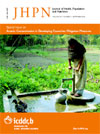
|
The Journal of Health, Population and Nutrition
icddr,b
ISSN: 1606-0997
EISSN: 1606-0997
Vol. 27, No. 6, 2009, pp. 763-771
|
 Bioline Code: hn09079
Bioline Code: hn09079
Full paper language: English
Document type: Research Article
Document available free of charge
|
|
|
The Journal of Health, Population and Nutrition, Vol. 27, No. 6, 2009, pp. 763-771
| en |
Index for Measuring the Quality of Complementary Feeding Practices in Rural India
Garg, Aashima & Chadha, Ravinder
Abstract
This community-based cross-sectional study was undertaken to develop a complementary feeding index
(CFI) to assess the adequacy of complementary feeding (CF) practices and determine its association with
growth of infants, aged 6-12 months, in rural Indian population. The study was conducted in six villages of
Ghaziabad district, Uttar Pradesh, India. A structured interview schedule was used for eliciting information
from 151 mothers of infants, aged 6-12 months, on CF practices. Data on CF practices were scored using
the CFI developed. Measurements of weight and length were taken. Bivariate and multivariate analyses
were done using the SPSS software (version 13). The results revealed that the CF practices were suboptimal
in the sample. The mean±standard deviation (SD) CFI scores ranged from a low value of 7.09±3.21 in 6-8
months old infants to a comparatively-higher value of 9.69±2.94 in 9-12 months old infants. Using the CFI
it could be identified that infants (n=151) had poor dietary diversity, with only 31% and 18% of the infants
reportedly being fed the recommended number of food-groups during 6-8 and 9-12 months respectively.
The food-frequency scores of the CFI showed that cereals and diluted animal milk were the major foodgroups
fed to the infants in this setting. Analysis of nutritional status revealed that 24.5% of the infants
were stunted (length-for-age [LAZ] <-2SD), 25% were underweight (weight-for-age [WAZ] <-2SD), and 17%
were wasted (weight-for-age [WLZ] <-2SD). Significant associations (p<0.05) were observed between the
meal-frequency and the dietary diversity of the CFs of infants aged 6-8 months and 9-12 months and
the WAZ and LAZ indices of their nutritional status. On multivariate analysis of factors affecting the LAZ,
WAZ and WLZ scores, the CFI was significantly associated (p<0.05) with LAZ whereas maternal education
and breastfeeding frequency were significantly (p<0.01) associated with WAZ and WLZ. Per-capita
income, parity, and birth-order were the significant (p<0.05) determinants of the CFI. The CFI developed
is an exploratory attempt to summarize and quantify the key CF practices into a composite index, which
would reflect the CF practices holistically. This index can be used as an easy tool by programme planners
for identifying, targeting, and monitoring the deficient CF practices and also advocating the importance
of the CF at policy level.
Keywords
Community-based studies; Complementary feeding index; Complementary feeding practices; Cross-sectional studies; Infant nutritional status; India
|
| |
© Copyright 2009 - International Centre For Diarrhoeal Disease Research, Bangladesh
Alternative site location: http://www.jhpn.net
|
|
